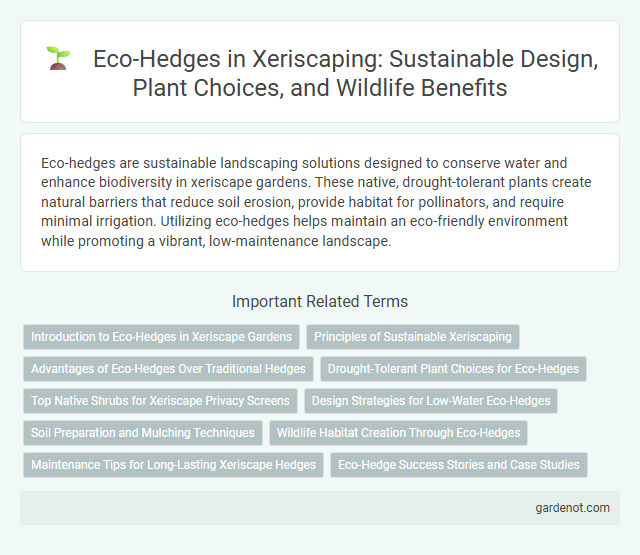Eco-hedges are sustainable landscaping solutions designed to conserve water and enhance biodiversity in xeriscape gardens. These native, drought-tolerant plants create natural barriers that reduce soil erosion, provide habitat for pollinators, and require minimal irrigation. Utilizing eco-hedges helps maintain an eco-friendly environment while promoting a vibrant, low-maintenance landscape.
Introduction to Eco-Hedges in Xeriscape Gardens
Eco-hedges in xeriscape gardens serve as sustainable, low-water landscaping solutions that enhance biodiversity and provide natural habitat for local wildlife. These hedges use drought-tolerant native plants, reducing irrigation needs while improving soil health and erosion control. Utilizing eco-hedges in xeriscaping supports water conservation efforts and creates resilient garden ecosystems adapted to arid climates.
Principles of Sustainable Xeriscaping
Eco-hedges in xeriscaping conserve water by utilizing drought-tolerant native plants that require minimal irrigation and maintenance. These sustainable barriers promote biodiversity and soil health, reducing the need for chemical fertilizers and pesticides. Integrating eco-hedges aligns with xeriscaping principles by enhancing landscape resilience and optimizing resource efficiency.
Advantages of Eco-Hedges Over Traditional Hedges
Eco-hedges offer significant water conservation advantages compared to traditional hedges, making them ideal for xeriscaping in arid regions. These drought-tolerant plants require minimal irrigation and support local biodiversity by providing habitat for pollinators and beneficial insects. Their low maintenance requirements reduce the need for fertilizers and pesticides, enhancing environmental sustainability.
Drought-Tolerant Plant Choices for Eco-Hedges
Eco-hedges utilize drought-tolerant plant choices such as lavender, rosemary, and Texas sage to create sustainable, water-efficient barriers. These plants offer deep root systems and low water requirements, making them ideal for xeriscaping in arid climates. Incorporating native species like desert willow and agave enhances resilience while conserving water resources.
Top Native Shrubs for Xeriscape Privacy Screens
Top native shrubs ideal for xeriscape privacy screens include Texas sage (Leucophyllum frutescens), known for drought tolerance and dense foliage, and Wolfberry (Lycium berlandieri), which provides thick coverage with minimal water needs. Desert willow (Chilopsis linearis) offers attractive blooms while thriving in arid conditions, making it perfect for natural privacy barriers. Incorporating these species into xeriscape designs enhances water efficiency and supports local ecosystems with robust, low-maintenance plantings.
Design Strategies for Low-Water Eco-Hedges
Design strategies for low-water eco-hedges emphasize the use of drought-tolerant native plants such as lavender, sage, and yucca to minimize irrigation needs. Incorporating mulching techniques and drip irrigation systems enhances soil moisture retention and reduces water consumption. Grouping plants with similar water requirements further optimizes hydration efficiency while promoting sustainable landscaping.
Soil Preparation and Mulching Techniques
Eco-hedges thrive with proper soil preparation involving deep tilling and the incorporation of organic compost to enhance nutrient retention and drainage. Mulching techniques using biodegradable materials such as wood chips or straw help maintain soil moisture, regulate temperature, and suppress weed growth, crucial for xeriscape landscapes. Consistent mulching combined with soil aeration promotes root health and reduces water consumption, aligning with sustainable xeriscaping principles.
Wildlife Habitat Creation Through Eco-Hedges
Eco-hedges provide essential shelter, nesting sites, and food sources for various wildlife species, promoting biodiversity in xeriscape landscapes. Incorporating native, drought-tolerant plants and diverse vegetation layers creates a thriving habitat that supports pollinators, birds, and small mammals. Their design enhances ecosystem resilience while reducing water usage, making eco-hedges a sustainable choice for wildlife habitat creation.
Maintenance Tips for Long-Lasting Xeriscape Hedges
Eco-hedges in xeriscaping require minimal watering and pruning to maintain their health and aesthetic appeal. Regularly inspect for pests and remove dead or damaged branches to promote vigorous growth and prevent disease. Applying mulch around the base conserves soil moisture and reduces weed growth, enhancing the longevity of xeriscape hedges.
Eco-Hedge Success Stories and Case Studies
Eco-hedge projects showcase remarkable water conservation by utilizing drought-tolerant native plants that thrive in xeriscape environments. Case studies highlight significant reductions in irrigation needs and maintenance costs, proving eco-hedges as sustainable landscaping solutions. Successful implementations in arid regions demonstrate improved biodiversity and soil health, reinforcing the eco-hedge model's environmental and economic benefits.
Eco-hedge Infographic

 gardenot.com
gardenot.com